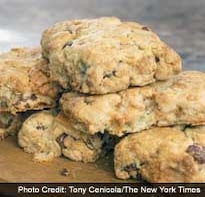The American scone is a confection in crisis. Puffy and pale, supersized and supersweet, it has lost its purpose. Is it a muffin? Is it a pastry? Does it exist to be frosted with icing, or spread with jam - or only to crumble into the crevices of car upholstery?
In baking both, a few things are certain: the dough should be handled as little as possible; butter is the best-tasting fat (though vegetable shortening and lard have their partisans); and bakers will never stop trying to improve them.
Master Recipe for Biscuits and Scones(The addition of sugar and egg turns this recipe for biscuits into a recipe for scones. The notes at the bottom of the recipe have amounts and instructions for making scones.)
Time: 30 minutes
Yield: 8 to 12 biscuits or scones3 cups all-purpose flour1 tablespoon baking powder1/4 pound (1 stick) cold unsalted butter, cubed1 cup heavy cream3 tablespoons melted butter (for biscuits) or 2 eggs beaten with 1 tablespoon water (for scones)1. Heat oven to 325 degrees. Line a sheet pan with parchment paper or baking mat, or use a nonstick pan.2. Toss dry ingredients together in a large bowl. Using your fingertips or a pastry cutter, rub butter and flour mixture together just until butter pieces are the size of peas and covered with flour. Make a well in the center of the bowl and pour in cream. Mix ingredients together by hand until a shaggy dough is formed.3. Turn out onto a floured surface and gently knead dough together just until smooth and all ingredients are incorporated.4. Pat dough into a 3/4- to 1-inch-thick rough rectangle shape. Use your hands if you like a nice bumpy top; for smooth tops, use a rolling pin, pressing lightly. Using a sharp knife or dough scraper, cut rectangle in half lengthwise, then cut across into 8 or 12 rectangles or squares. Place them on the baking sheet, spaced out.5. Brush tops with melted butter (for biscuits) or egg wash (for scones). Bake until light golden brown, about 22 minutes; rotate the pan front to back halfway through. Let cool slightly on the baking sheet. Serve warm or at room temperature. Eat within 24 hours.Note: To make scones, add 2 tablespoons sugar to the dry ingredients. With the cream, add 1 lightly beaten egg. Brush tops with egg wash and sprinkle with 2 tablespoons brown sugar. To make orange-currant scones, make changes above. Additionally, mix freshly grated zest of 1 orange or tangerine with the dry ingredients. When mixing or kneading the dough, add 1 cup currants and knead just until incorporated.©2014 New York Times News Service
In baking both, a few things are certain: the dough should be handled as little as possible; butter is the best-tasting fat (though vegetable shortening and lard have their partisans); and bakers will never stop trying to improve them.
Advertisement
Advertisement
Advertisement
Advertisement
Master Recipe for Biscuits and Scones(The addition of sugar and egg turns this recipe for biscuits into a recipe for scones. The notes at the bottom of the recipe have amounts and instructions for making scones.)
Time: 30 minutes
Yield: 8 to 12 biscuits or scones3 cups all-purpose flour1 tablespoon baking powder1/4 pound (1 stick) cold unsalted butter, cubed1 cup heavy cream3 tablespoons melted butter (for biscuits) or 2 eggs beaten with 1 tablespoon water (for scones)1. Heat oven to 325 degrees. Line a sheet pan with parchment paper or baking mat, or use a nonstick pan.2. Toss dry ingredients together in a large bowl. Using your fingertips or a pastry cutter, rub butter and flour mixture together just until butter pieces are the size of peas and covered with flour. Make a well in the center of the bowl and pour in cream. Mix ingredients together by hand until a shaggy dough is formed.3. Turn out onto a floured surface and gently knead dough together just until smooth and all ingredients are incorporated.4. Pat dough into a 3/4- to 1-inch-thick rough rectangle shape. Use your hands if you like a nice bumpy top; for smooth tops, use a rolling pin, pressing lightly. Using a sharp knife or dough scraper, cut rectangle in half lengthwise, then cut across into 8 or 12 rectangles or squares. Place them on the baking sheet, spaced out.5. Brush tops with melted butter (for biscuits) or egg wash (for scones). Bake until light golden brown, about 22 minutes; rotate the pan front to back halfway through. Let cool slightly on the baking sheet. Serve warm or at room temperature. Eat within 24 hours.Note: To make scones, add 2 tablespoons sugar to the dry ingredients. With the cream, add 1 lightly beaten egg. Brush tops with egg wash and sprinkle with 2 tablespoons brown sugar. To make orange-currant scones, make changes above. Additionally, mix freshly grated zest of 1 orange or tangerine with the dry ingredients. When mixing or kneading the dough, add 1 cup currants and knead just until incorporated.©2014 New York Times News Service
For the latest food news, health tips and recipes, like us on Facebook or follow us on Twitter and YouTube.
Advertisement
